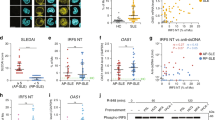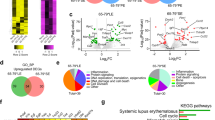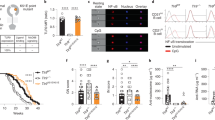Abstract
Several studies have described a role for type I interferons (IFNαβ) in the initiation and/or prolongation of autoimmune diseases. Most pronounced has been the association of disease activity with what is now known as ‘the interferon signature’ of gene expression in peripheral blood mononuclear cells from lupus patients. In correlation, studies have shown that inhibition of IFNαβ signaling abrogates disease in various mouse models of lupus. New Zealand black (NZB) and B6.Nba2 congenic mice spontaneously develop elevated levels of serum anti-nuclear autoantibodies (ANAs). Nevertheless, neither of these strains develop fatal renal disease. The female F1 offspring of NZB or B6.Nba2 crossed with New Zealand white (NZW) mice do, however, develop kidney disease. We have previously shown that increases in endogenous IFNαβ levels in (B6.Nba2 × NZW)F1 mice leads to accelerated development of renal disease in an IFNαβ-dependent manner. We now show that B6.Nba2 and (B6.Nba2 × NZW)F1 mice deficient for the IFNαβ-receptor fail to develop ANA and renal disease, although the mice have substantial immune complex deposition in the glomeruli. Thus, endogenous IFNαβ might influence disease by affecting B-cell activation and differentiation, as well as the kidneys’ susceptibility to damage, the latter perhaps through induction of a local inflammatory milieu.
This is a preview of subscription content, access via your institution
Access options
Subscribe to this journal
Receive 6 digital issues and online access to articles
$119.00 per year
only $19.83 per issue
Buy this article
- Purchase on Springer Link
- Instant access to full article PDF
Prices may be subject to local taxes which are calculated during checkout





Similar content being viewed by others
References
Kotzin BL, West SG . Systemic Lupus Erythematosus. In: Rich R, Shearer WT, Kotzin BL, Schroeder Jr HW (eds). Clinical Immunology. Principles and Practice. Mosby International Limited: PA, 2001, pp 60.1–60.24.
Bennett L, Palucka AK, Arce E, Cantrell V, Borvak J, Banchereau J et al. Interferon and granulopoiesis signatures in systemic lupus erythematosus blood. J Exp Med 2003; 197: 711–723.
Baechler EC, Batliwalla FM, Karypis G, Gaffney PM, Ortmann WA, Espe KJ et al. Interferon-inducible gene expression signature in peripheral blood cells of patients with severe lupus. Proc Natl Acad Sci USA 2003; 100: 2610–2615.
Jørgensen TN, Thurman J, Izui S, Falta MT, Metzger TE, Flannery SA et al. Genetic susceptibility to PolyI:C-induced IFNα/β-dependent accelerated disease in lupus-prone mice. Genes Immun 2006; 7: 555–567.
Kirou KA, Lee C, George S, Louca K, Peterson MG, Crow MK . Activation of the interferon-alpha pathway identifies a subgroup of systemic lupus erythematosus patients with distinct serologic features and active disease. Arthritis Rheum 2005; 52: 1491–1503.
Theofilopoulos AN, Dixon FJ . Murine models of systemic lupus erythematosus. Adv Immunol 1985; 37: 269–390.
Nath KA . Tubulointerstitial changes as a major determinant in the progression of renal damage. Am J Kidney Dis 1992; 20: 1–17.
Rozzo SJ, Allard JD, Choubey D, Vyse TJ, Izui S, Peltz G et al. Evidence for an interferon-inducible gene, Ifi202, in the susceptibility to systemic lupus. Immunity 2001; 15: 435–443.
Vyse TJ, Drake CG, Rozzo SJ, Roper E, Izui S, Kotzin BL . Genetic linkage of IgG autoantibody production in relation to lupus nephritis in New Zealand hybrid mice. J Clin Invest 1996; 98: 1762–1772.
Gubbels MR, Jørgensen TN, Metzger TE, Menze K, Steele H, Flannery SA et al. Effects of MHC and gender on lupus-like autoimmunity in Nba2 congenic mice. J Immunol 2005; 175: 6190–6196.
Xie C, Zhou XJ, Liu X, Mohan C . Enhanced susceptibility to end-organ disease in the lupus-facilitating NZW mouse strain. Arthritis Rheum 2003; 48: 1080–1092.
Atencio S, Amano H, Izui S, Kotzin BL . Separation of the New Zealand Black genetic contribution to lupus from New Zealand Black determined expansions of marginal zone B and B1a cells. J Immunol 2004; 172: 4159–4166.
Stohl W, Xu D, Kim KS, Koss MN, Jørgensen T, Deocharan B et al. BAFF overexpression and accelerated glomerular disease in mice with an incomplete genetic predisposition to systemic lupus erythematosus. Arthritis Rheum 2005; 52: 2080–2091.
Peng SL, Szabo SJ, Glimcher LH . T-bet regulates IgG class switching and pathogenic autoantibody production. Proc Natl Acad Sci USA 2002; 99: 5545–5550.
Marrack P, Kappler J, Mitchell T . Type I interferons keep activated T cells alive. J Exp Med 1999; 189: 521–530.
Pramanik R, Jørgensen TN, Xin H, Kotzin BL, Choubey D . Interleukin-6 induces expression of Ifi202, an interferon-inducible candidate gene for lupus susceptibility. J Biol Chem 2004; 279: 16121–16127.
Santiago-Raber ML, Baccala R, Haraldsson KM, Choubey D, Stewart TA, Kono DH et al. Type-I interferon receptor deficiency reduces lupus-like disease in NZB mice. J Exp Med 2003; 197: 777–788.
Mathian A, Weinberg A, Gallegos M, Banchereau J, Koutouzov S . IFN-α induces early lethal lupus in preautoimmune (New Zealand Black × New Zealand White)F1 but not in BALB/c mice. J Immunol 2005; 174: 2499–2506.
Hron JD, Peng SL . Type I IFN protects against murine lupus. J Immunol 2004; 173: 2134–2142.
Deocharan B, Qing X, Lichauco J, Putterman C . α-Actinin is a cross-reactive renal target for pathogenic anti-DNA antibodies. J Immunol 2002; 168: 3072–3078.
Xie C, Liang Z, Chang S, Mohan C . Use of a novel elution regimen reveals the dominance of polyreactive antinuclear autoantibodies in lupus kidneys. Arthritis Rheum 2003; 48: 2343–2352.
Kalaaji M, Sturfelt G, Mjelle J, Nossent H, Rekvig O . Critical comparative analyses of anti-alpha-actinin and glomerulus-bound antibodies in human and murine lupus nephritis. Arthritis Rheum 2006; 54: 914–926.
Kalaaji M, Mortensen E, Jorgensen L, Olsen R, Rekvig O . Nephritogenic lupus antibodies recognize glomerular basement membrane-associated chromatin fragments released from apoptotic intraglomerular cells. Am J Pathol 2006; 168: 1779–1792.
Qing X, Zavadil J, Crosby M, Hogarth M, Hahn B, Mohan C et al. Nephritogenic anti-DNA antibodies regulate gene expression in MRL/lpr mouse glomerular mesangial cells. Arthritis Rheum 2006; 54: 2198–2210.
Patole PS, Grone HJ, Segerer S, Ciubar R, Belemezova E, Henger A et al. Viral double-stranded RNA aggravates lupus nephritis through Toll-Like Receptor 3 on glomerular mesangial cells and antigen-presenting cells. J Am Soc Nephrol 2005; 16: 1326–1338.
Satoh J, Nanri Y, Tabunoki H, Yamamura T . Microarray analysis identifies a set of CXCR3 and CCR2 ligand chemokines as early IFNβ-responsive genes in peripheral blood lymphocytes in vitro: an implication for IFNβ-related adverse effects in multiple sclerosis. BMC Neurol 2006; 6: 18–34.
Perez de Lema G, Maier H, Nieto E, Vielhauer V, Luckow B, Mampaso F et al. Chemokine expression precedes inflammatory cell infiltration and chemokine receptor and cytokine expression during the initiation of murine lupus nephritis. J Am Soc Nephrol 2001; 12: 1369–1382.
Dai C, Liu Z, Zhou H, Li L . Monocyte chemoattractant protein-1 expression in renal tissue is associated with monocyte recruitment and tubulo-interstitial lesions in patients with lupus nephritis. Chin Med J (England) 2001; 114: 864–868.
Luzina I, Atamas S, Storrer C, daSilva L, Kelsoe G, Papadimitriou J et al. Spontaneous formation of germinal centers in autoimmune mice. J Leukoc Biol 2001; 70: 578–584.
Connolly K, Roubinian JR, Wofsy D . Development of murine lupus in CD4-depleted NZB/NZW mice. Sustained inhibition of residual CD4+ T cells is required to suppress autoimmunity. J Immunol 1992; 149: 3083–3088.
Adachi Y, Inaba M, Sugihara A, Koshiji M, Sugiura K, Amoh Y et al. Effects of administration of monoclonal antibodies (anti-CD4 or anti-CD8) on the development of autoimmune diseases in (NZW × BXSB)F1 mice. Immunobiology 1998; 198: 451–464.
Mohan C, Yu Y, Morel L, Yang P, Wakeland EK . Genetic dissection of Sle pathogenesis: Sle3 on murine chromosome 7 impacts T cell activation, differentiation, and cell death. J Immunol 1999; 162: 6492–6502.
Stohl W, Xu D, Metzger TE, Kim KS, Morel L, Kotzin BL . Dichotomous effects of complete versus partial class II major histocompatibility complex deficiency on circulating autoantibody levels in autoimmune-prone mice. Arthritis Rheum 2004; 50: 2227–2239.
Wang H, Chatterjee G, Meyer JJ, Liu CJ, Manjunath NA, Bray-Ward P et al. Characteristics of three homologous 202 genes (Ifi202a, Ifi202b, and Ifi202c) from the murine interferon-activatable gene 200 cluster. Genomics 1999; 60: 281–294.
Trapani JA, Browne KA, Dawson MJ, Ramsay RG, Eddy RL, Show TB et al. A novel gene constitutively expressed in human lymphoid cells is inducible with interferon-gamma in myeloid cells. Immunogenetics 1992; 36: 369–376.
Choubey D, Lengyel P . Binding of an interferon-inducible protein (p202) to the retinoblastoma protein. J Biol Chem 1995; 270: 6134–6140.
D’Souza S, Xin H, Walter S, Choubey D . The gene encoding p202, an interferon-inducible negative regulator of the p53 tumor suppressor, is a target of p53-mediated transcriptional repression. J Biol Chem 2001; 276: 298–305.
Xin H, D’Souza S, Jørgensen TN, Vaughan AT, Lengyel P, Kotzin BL et al. Increased expression of Ifi202, an IFN-activatable gene, in B6.Nba2 lupus susceptible mice inhibits p53-mediated apoptosis. J Immunol 2006; 176: 5863–5870.
Muller U, Steinhoff U, Reis LF, Hemmi S, Pavlovic J, Zinkernagel RM et al. Functional role of type I and type II interferons in antiviral defense. Science 1994; 264: 1918–1921.
Vyse TJ, Rozzo SJ, Drake CG, Izui S, Kotzin BL . Control of multiple autoantibodies linked with a lupus nephritis susceptibility locus in New Zealand black mice. J Immunol 1997; 158: 5566–5574.
Acknowledgements
This study was funded by The Denver Autoimmunity Center of Excellence (#AI46374-07) (TNJ, PM, BLK).
Author information
Authors and Affiliations
Corresponding author
Additional information
Financial interests
The authors have no financial interests relevant to the research.
Rights and permissions
About this article
Cite this article
Jørgensen, T., Roper, E., Thurman, J. et al. Type I interferon signaling is involved in the spontaneous development of lupus-like disease in B6.Nba2 and (B6.Nba2 × NZW)F1 mice. Genes Immun 8, 653–662 (2007). https://doi.org/10.1038/sj.gene.6364430
Received:
Revised:
Accepted:
Published:
Issue Date:
DOI: https://doi.org/10.1038/sj.gene.6364430
Keywords
This article is cited by
-
Myeloid Populations in Systemic Autoimmune Diseases
Clinical Reviews in Allergy & Immunology (2017)
-
A pathogenic IFNα, BLyS and IL-17 axis in Systemic Lupus Erythematosus patients
Scientific Reports (2016)
-
Phenotypic and functional alterations of pDCs in lupus-prone mice
Scientific Reports (2016)
-
Intrinsic autoimmune capacities of hematopoietic cells from female New Zealand hybrid mice
Genes & Immunity (2014)
-
The role of dendritic cells in autoimmunity
Nature Reviews Immunology (2013)



